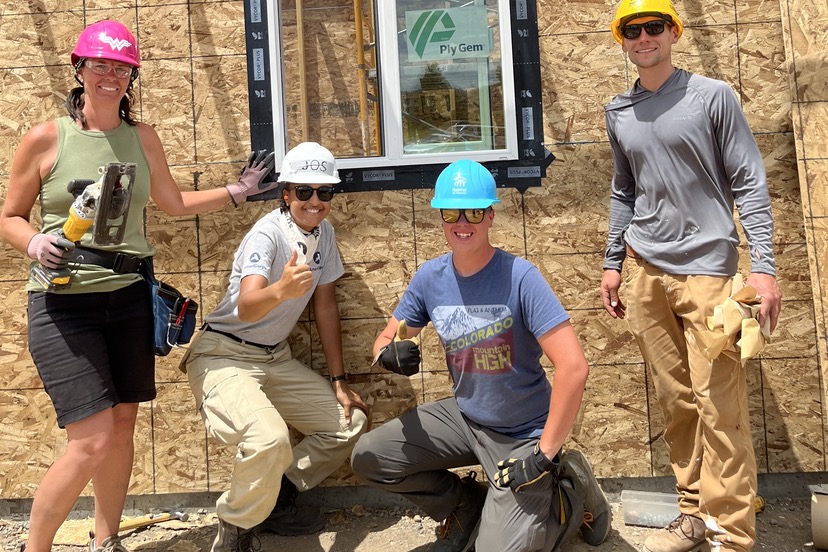Photo courtesy Habitat Archuleta.
I will be writing tomorrow, or maybe Monday, about the public interview process for a new School Director at Pagosa Peak Open School, to take place Monday afternoon at the school. Three finalists have been selected for interviews by staff, parents, students, and the school’s Board of Directors.
Two of the finalists do not currently live here in Pagosa, and I wonder if they have taken the time to thoroughly research our housing market?
And the overall cost of living here?
This morning, looking out the window at maybe three inches of snow that accrued overnight downtown, I’m assuming we got even more snow up in the San Juan Mountains to the north and east of Pagosa. Skiers and snowboarders — locals and spring break visitors — will no doubt be smiling at the thought of fresh powder at Wolf Creek Ski Area for the coming weekend. Those of us (like myself) who serve on water district boards (and who maybe haven’t been skiing for the past decade) might see the snow through a slightly different lens: a temporary bank account of frozen water that will fill our streams and reservoirs in the spring, and hopefully get us through the summer months with sufficient drinking water and irrigation water.
The Pagosa Area Water and Sanitation District (PAWSD) will hold a Board meeting tonight at 5pm at the District office, 100 Lyn Avenue, and may make some important decisions about the cost of living here in our little mountain community.
Disclosure: I currently serve as a volunteer on the PAWSD Board of Directors, but this editorial reflects only my own personal opinions, and not necessarily the opinions of the PAWSD Board as a whole, nor of the PAWSD staff.
Last month, the PAWSD Board approved the schedule of fees for 2024, following a public hearing. The monthly rates for water and wastewater were increased slightly, but the fees paid by new construction were increased rather dramatically. Many years ago, the PAWSD Board determined that, although growth might have certain positive effects on the local economy, any added strain on the district’s infrastructure — larger pipes, increased staffing, enlarged storage tanks, bigger pumps — should be compensated not by the existing customers but by the new growth itself. Especially, the financial cost ought to be compensated.
With that philosophy in mind, the PAWSD Board last month increased the district’s Capital Investment Fees for a new house in the uptown area from $6,532 to $24,665, to help cover upgrades to the water and wastewater systems required by the Colorado Department of Public Health and Environment.
According to my pocket calculator, this adds about $18,000 to the price of a new home. Some people, with good credit scores and financial resources, will be able to roll this amount into their mortgage loan and pay it off over 30 years. But for some households, $18,000 in additional costs will put a new home out of their price range.
If the homes are already out of their price range, of course. Which is typically the case for a suburban home in the Pagosa Lakes subdivisions lately, priced at more than $500,000 in a town where an average working household sees an income of less than $60,000 a year.
At last month’s public hearing concerning the PAWSD fee increases, several members of the public urged PAWSD to consider the impacts of an $18,000 cost increase on new workforce housing projects.
Two local non-profits — Habitat Archuleta and the Pagosa Springs Community Development Corporation (PSCDC) — are currently planning to build new homes, during 2024, aimed that just those workforce families who would otherwise not qualify for a mortgage on a $500,000 home. Habitat hopes to build three homes this year. PSCDC hopes to build 10 homes. All these homes will be offered to families earning less than the Area Median Income.
Both non-profits are planning to build their homes in the Trails and Chris Mountain subdivisions, where Pagosa Lakes Property Owners Association regulations — regulations specifically aimed at ‘preserving property values’ for neighboring homes — make it difficult to design and build a new home for less than $400,000. But a family earning less than the Area Median Income cannot easily afford a home costing more than about $280,000.
The Archuleta Board of County Commissioners donated the parcels for the planned 13 homes, and additionally, has been working with Habitat and PSCDC to obtain Colorado grants that will make affordable housing feasible in Trails and Chris Mountain. A $1.9 million grant, for example, will improve the substandard roads in those subdivisions, and install the electrical service that the original developer never installed, back in the 1970s. But that grant is partly dependent upon new workforce homes promised within the subdivision.
Is PAWSD willing to waive the entire CIF — the full $24,665 per home — to help bring down the final cost of these 13 homes?
That would amount to $320,000 in donated fees.
Last week, the PAWSD Board held a work session, and tossed around some ideas for modifying its existing ‘affordable housing waiver’ policy, originally approved in 2020. At their meeting tonight, the Board will hear presentations by Habitat and PSCDC, explaining the importance of continued water and wastewater subsidies to encourage new workforce housing. A draft resolution included in tonight’s meeting packet proposes a full waiver of fees for apartments and homes that serve households earning 80% or less of the Area Median Income. Those are the households in our community typically struggling most, to find safe, well-maintained, affordable shelter.
Will Habitat and PSCDC be able to build new homes affordable to those families? Are water district waivers necessary to make that happen?
You can download the Habitat presentation here.
You can download the PSCDC presentation here.
You can attend the meeting tonight at 5pm.

